Many of us have seen and heard the auctioneer’s hammer crash down on the final bid of a famous well-fought-over item.
What interests me – apart from the artifact itself – is the seller. What is his or her background? Why the sale? Is this is a one-off event or does he or she have more to offer? What brought them to this hammer time?
To answer these questions I sought counsel from three of the industry’s most prolific auctioneers. Aurel Bacs is head of the watch department at Phillips in Association With Bacs & Russo. His most famous sale to date (and the most expensive wristwatch ever sold) was the recent auction of Paul Newman’s personal Rolex Daytona, which hammered for $17.75 million (see Paul Newman’s Own Rolex Daytona Reference 6239 Breaks World Auction Record, Sells For $17,752,500).
I was also privileged to speak with Jonathan Darracott, Bonhams’ global head of watches. Darracott was responsible for sale of the Graves supercomplication watch by Patek Philippe in 1999 for $11 million as part of an entire collection that hammered for $36 million.
Rounding out my watch-selling experts is Katharine Thomas, head of Sotheby’s Watches & Clocks department in New York. Among her successes on the auction podium is the sale of Franklin D. Roosevelt’s Cartier Victory Clock, setting a world record at the time of $1.6 million for a Cartier timepiece.
Aurel Bacs of Phillips closes in on the winning bid for the Paul Newman Rolex Daytona in October 2017
Who sells their watches?
The opinion from all three watch specialists is that there’s no average seller. “Each seller and the story behind each watch is different,” Phillips’ Bacs says. “Every day may bring someone with a story we haven’t heard before.”
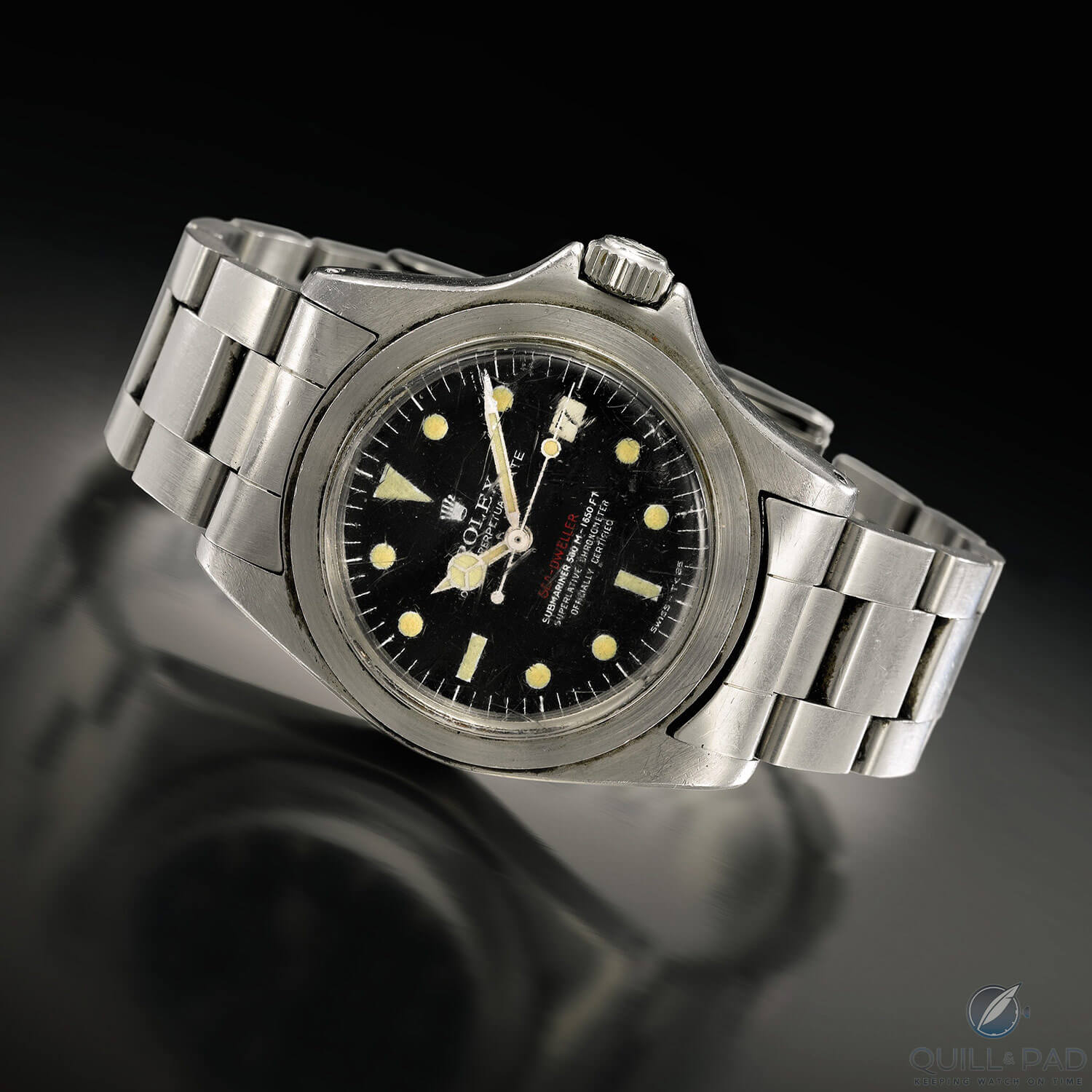
A prototype Rolex Sea-Dweller without the helium escape valve sold at Sotheby’s in 2013 (photo courtesy Sotheby’s)
Thomas of Sotheby’s told me about a man who came into the New York office with an oldish watch back in 2013. It turns out it was a prototype Rolex Sea-Dweller without the helium escape valve. During 1967 Rolex was working with the U.S. Navy and its UDT group (predecessor to the SEALs) to develop a watch to their specifications. Also, the watch’s bezel had exploded off the case during testing – making it a real collector’s artifact with a story. Thomas sold it for $350,000.
“You just never know who is on the other end of the phone and what they have,” she says.
For the most part, watch sellers fall into five categories:
- Seasoned collectors who know the market and the trends. They may sell to create space in their collections and additional dry powder for future purchases.
- Dealers who make their living buying and selling watches out of inventory.
- One-off sellers with a single piece to sell. Maybe it was a gift or inherited, and the seller wants to liquefy the asset. The opening conversation often begins, “I have this watch, don’t know what it is or what it’s worth. Help me.” With cell phones today, the prospective seller just has to take a photo of the piece and message it to the specialist who will know very quickly if it warrants a personal visit.
- Benefactors may also be sellers. Say someone has one very valuable timepiece, but two or more beneficiaries they want to leave it to. Impossible? Hardly. Sell it and distribute the proceeds.
- A once-serious watch collector may decide to collect something else and sell an entire collection in one auction. Bacs at Phillips says, “That is how we may get between 50 and over 100 watches to sell from the same person. In such cases we may spread it out over two or three seasons to achieve the best prices – especially if the collection contains duplicates.”
Celebration: Nathalie Monbaron (center, on phone) and the Phillips team following the sale of the Paul Newman Rolex Daytona
Why sell?
Darracott at Bonhams sees two frequent reasons: piece(s) may be sold to buy another or there may be a wish to upgrade the collection by replacing a piece that’s already in it with a version that’s rarer and more valuable.
Since upgrading has a cost, there might be a need to sell one or more pieces to acquire the upgraded piece. Phillips’ Bacs adds, “Some may have a watch that’s appreciated way too much to actually wear. So it just sits in a drawer or a safe. They want to sell it.”
I would add that some sellers may own watches that have become so valuable that they have become too large a part of the net worths. They may want to utilize the asset values for something else in their lives. Selling the watch achieves that goal.
Selecting watch(es) to be sold
If you’re a collector or happen to have a few watches to sell, this may not be such an easy decision. Each watch may have a history with you, sentimental value, or you just may really like it. Be strong. You’ve already made the tough decision: something must go. Detach yourself from the emotion of choosing which gets cut from the flock.
Here are some of the things the experts look at when helping a client decide which piece(s) to sell.
Wrist time: Some people are happy to have one or more watches that just sit in a display case. That’s not me. Maybe it’s not you either. If you have a watch that sees little wrist time for whatever reason, it may be time to sell it.
Excuses for not wearing it: This goes along with (tragically) low wrist time. People who dream up reasons for not wearing a piece might consider replacing it with something they’ll enjoy using for its intended purpose.
It needs expensive servicing: Fine timepieces require care. If a piece is already in your crosshairs for low wrist time, an upcoming servicing may just be what pushes you into the auctioneer’s office.
Taste has changed: According to Darracott at Bonham’s, this is the single biggest reason for selling a timepiece. People sometimes just want a change of scenery.
Rebalancing the collection: Like with a securities portfolio, sometimes we develop an undue concentration on one brand, style, or type. It can happen over time without notice. Additionally, undue concentration may move toward rapidly appreciating pieces, giving them a disproportionate share of the collection’s overall value.
While this might be a good thing, nevertheless having so much capital tied up in one or two pieces might signal it’s time to declare victory and move on.
Storage space: Sometimes the decision to sell can be no more complicated than the need to free up a place in the watch winder for a new piece.
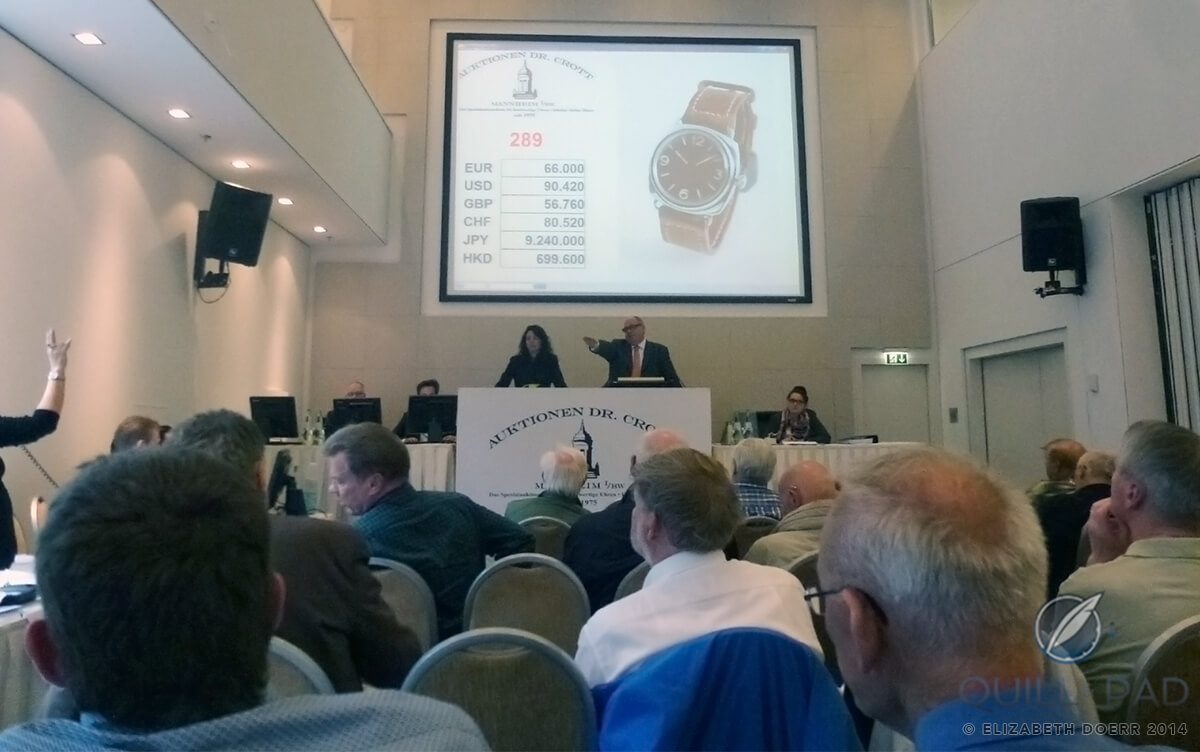
A Dr. Crott auction in Frankfurt
Prep to sell
There are definitely some dos and don’ts when prepping a watch for sale. Bacs, Darracott, and Thomas all agree that sellers need to do the right kind of prep work to achieve the greatest value for their watches.
The first step is to accumulate all the paperwork ever associated with the watch. Be sure to include the guarantee cards and/or certificates and instruction manual.
“But don’t stop there,” Bacs says. “Anything that’s associated with the watch is probably of interest to those bidding on the piece. If you inherited it you may not have ever been given the paperwork. Look for it. Ask family members if they have it. Get photos of the person wearing it. The more famous the kin the better. Many watches have associated correspondence. Letters back and forth from the manufacturer, authorized dealer, or servicer are common and establish provenance.”
Even something as simple as the advertisement for the piece can help jack up its price.
Absolutely get the original presentation box and instruction manual if you can. If not, then you may consider buying them on the aftermarket. It’s not usually as good as the original but a period- and model correct-presentation box and manual makes a more complete package for the sale. Also, for some collectors the cardboard shipping box the entire package came in from the manufacturer to the authorized dealer is sometimes of interest.
Bottom line, the more complete the package – hang tags, protective plastic, and anything else – the more value you’ve added to the buyer. If you’re using a reputable auction house, let the specialist you’re working with tell you what’s important for your particular piece.
Some pieces have a context apart from just the watch. For example, some manufacturers create special production runs (logo watches) for corporate customers. If a company had a top-end watch made, they probably had other things made as well. If you can gather some of these ephemera, it creates a context that the auctioneer may use to generate interest and possibly add value to the bidding.

Ready to bid at the 2017 Only Watch Auction
Service before sale?
Consensus among the experts is that having your watch serviced before an auction is probably not a good idea.
“Servicing can introduce a fault that was not there originally,” Darracott says.
Bacs adds, “Let the specialist decide if and what kind of servicing should be done to the watch. For example, when we sold Paul Newman’s Rolex Daytona, the piece was scratched – probably by Paul Newman himself.”
Bacs didn’t have to say that such evidence of use by the beloved actor added extraordinary value. In this case, restoring the piece to its original condition would have been a crime. Such ham-fisted handling of the piece would likely have diminished its hammer price considerably.
“At Sotheby’s we open up all pieces,” Thomas says. “We want to be sure of what we’re getting.” Aside from condition issues that only opening the watch reveals, there are sometimes parts that don’t belong. Maybe they were cannibalized from the same brand or even the same model, but from a different year.
These imperfections may seem minor at first, but the auctioneers’ reputations are on the line with each piece. Their responsibility is to present the piece as it actually is; not what it once was or could be again with some restoration.
The buyer has the responsibility of doing sufficient due diligence to know what he or she is getting and asking the appropriate questions before the bidding begins.
Whether you choose to engage the services of an auction house to sell your watch or not, seek qualified advice to assist in any decisions regarding servicing the piece before sale. Two areas of risk come to mind.
- The new owner may want his people to do the servicing, and anything you do, in the best case, might increase value only by the cost of service and, worst case, diminish its value.
- Your servicer botches the job and irretrievably lowers the piece’s value.
Bacs cautions about choosing the right servicer if you decide to do some work on the piece. “A watchmaker is probably not the person to talk with about servicing a piece. He’ll want to restore it to its original pristine condition. That may not be what will fetch the best result in a sale.”
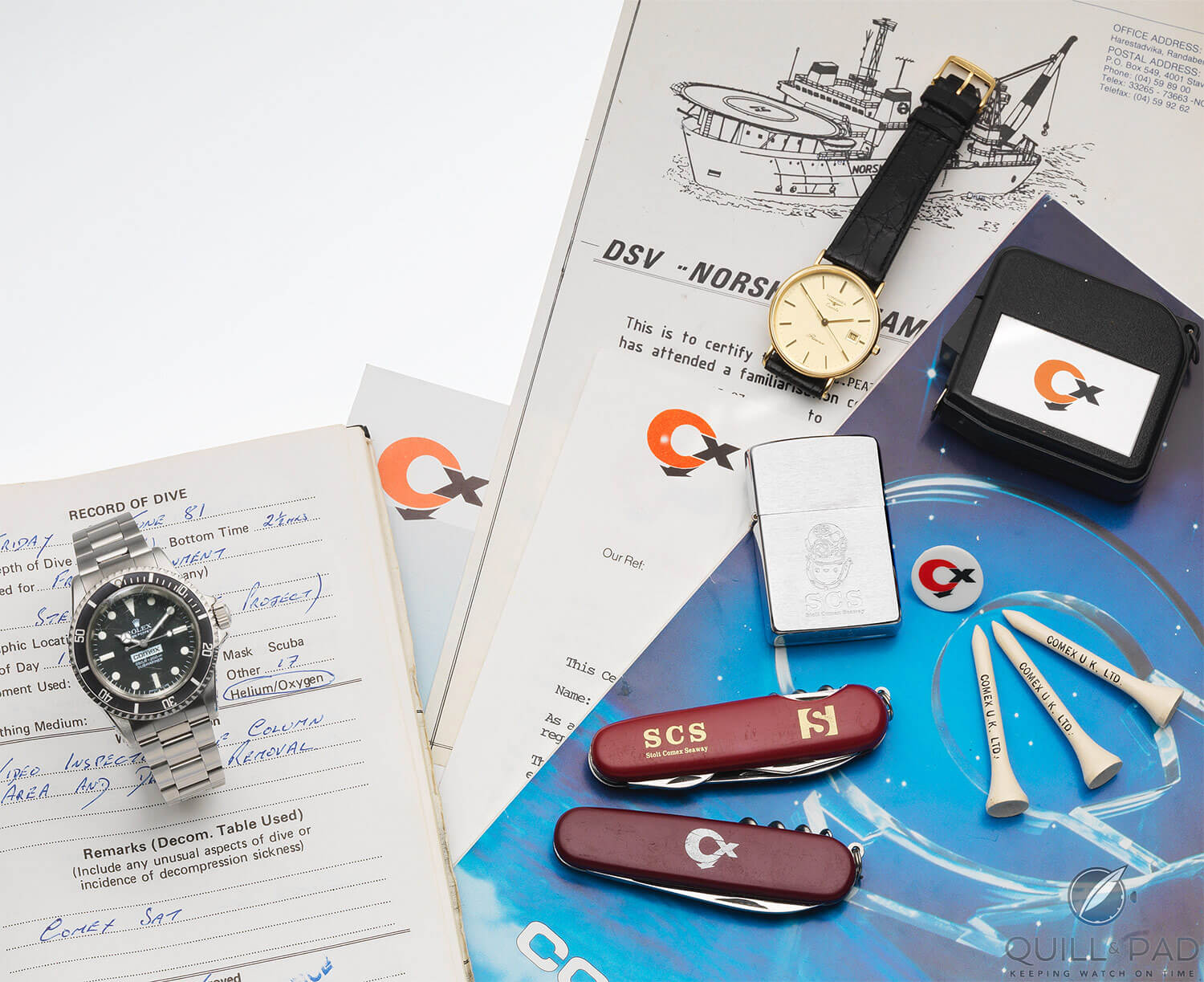
Rolex Submariner with associated ephemera (photo courtesy Bonhams)
Modes of selling
There are many markets in which to sell a valuable timepiece. The most common are private parties, reputable auction houses, and dealers. There are pros and cons with each sale venue.
Pros and Cons of Various Sale Venues
Unknown private party
Risk: High, known only by reputation
Cost: Low, no auction or broker’s fees, no commission
Delay: Probably weeks if buyer is foreign. Shipping and evaluation take time and is expensive if insured
Best price: Unlikely, no competition bidding for the piece and pushing price to maximum.
Auction houses
Risk: Low, strong laws protect customers. Maximized price if item in demand. If privacy is important, auction houses have reputations for discretion
Cost: Substantial, seller pays a percentage of the hammer price, giving the auctioneer financial incentive to get the best price
Delay: Months or more, watch auctions are planned and marketed well in advance. Then after it’s over may take 30 days more to get paid
Best price: Likely, worldwide promotion draws bidders from all over the world
Professional dealers
Risk: Low, if dealing with a reputable dealer
Cost: Substantial, will buy at a negotiated discount (called a haircut)
Delay: Relatively quickly, may take a week or less. Also, they may arrange a swap of watches from their inventory
Best price: Medium, wholesale price offered the seller will likely be competitive
Friends
Risk: Low, huge trust
Cost: Low, no auction or broker’s fees, no commission
Delay: Very fast, often within a day
Best price: Low, no competition so don’t know the true value
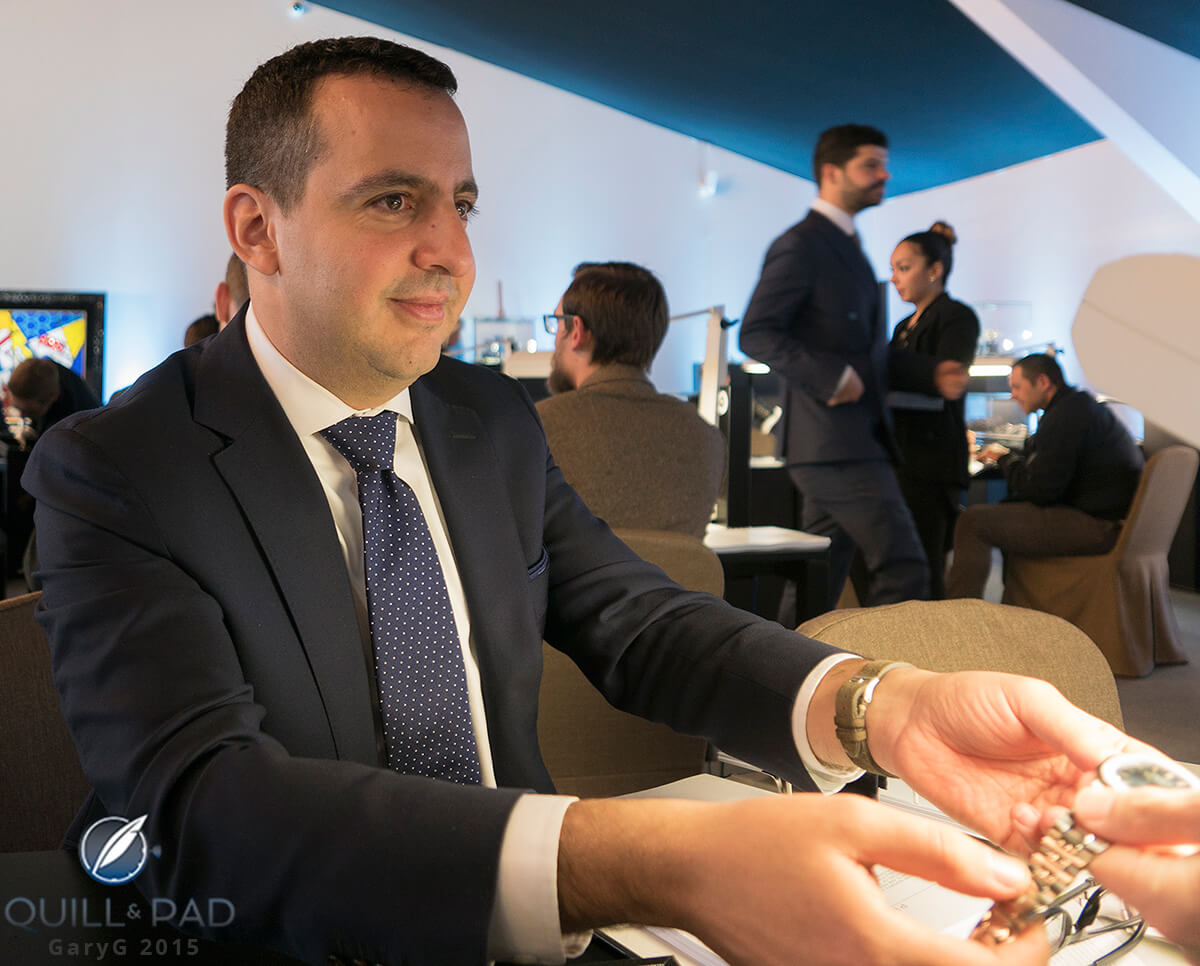
Phillips/Bacs and Russo consultant Paul Boutros shares watches and knowledge in Geneva
Some of the best stories of watches arise from auctioneers. Most of us have heard the backstory surrounding Paul Newman’s Rolex Daytona (but if not, read Paul Newman’s Own Paul Newman Rolex Daytona To Go Up For Auction).
But what about Elvis Presley’s diamond-studded Omega? Phillips in Association with Bacs & Russo is auctioning this piece at the Geneva Watch Auction: SEVEN on May 12-13, 2018.
The story goes that RCA Victor presented the watch to Presley in 1960 in recognition of him reaching 75 million records sold. The King then traded the piece to his uncle for a diamond-studded Hamilton he was wearing.
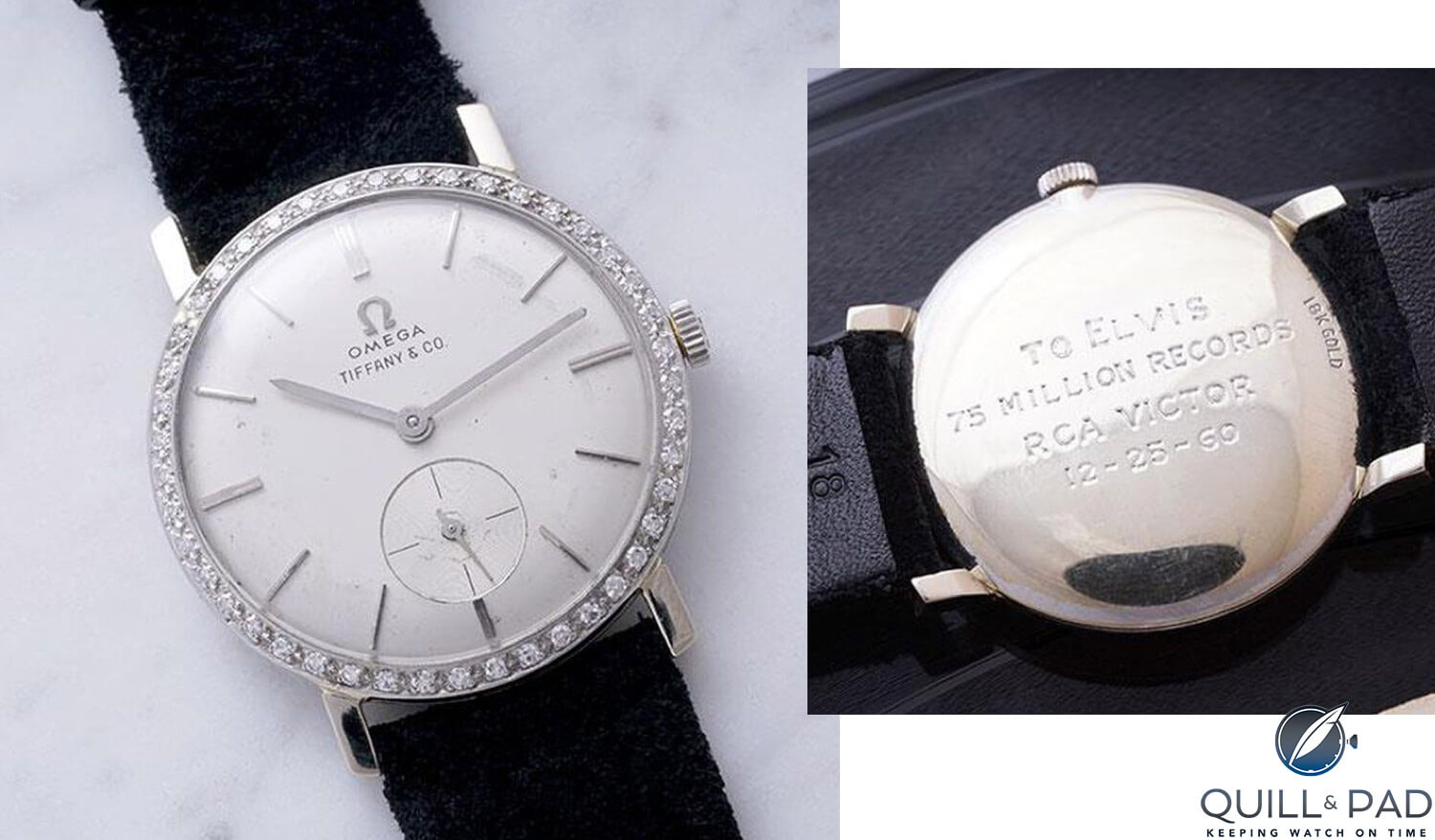
Elvis Presley’s Omega Caliber 510, estimate at Philipps May 2018 auction $58,000 to $108,000
The Omega was passed down through the family and is now being auctioned. See more about the rock-and-roll icon’s penchant for watches in Elvis Is In The Building: In Honor Of The King And His Watches.
Establishing the price
This is one of those times when paying for the right advice is far less expensive than the cost of being wrong. “Pricing timepieces is complex and often confusing,” Bacs says. “There’s considerable scholarship involved. Prices are published so you can get an estimate. Yet each piece has so many variables that greatly affect its value. Pricing is a field where you want a professional who knows the market, knows your watch, and most importantly, knows what they’re talking about.”
Sotheby’s Thomas talks about the importance of comparing apples to apples when using comparable sales figures. “Rarity or unique attributes of the piece can drive up its price. Then there’s the provenance if it is famous or belonged to someone famous.”
Proving such things is sometimes an iffy proposition. Even photos of the owner wearing the watch can be doctored. Condition of the piece also figures into the equation and will affect the usefulness of comparable sales figures.
Darracott at Bonhams adds, “Having the right (authentic) paperwork for the piece will definitely add value. Then there is the relative strength or softness of the market, for that particular piece.”
All of these things fall under a professional’s expertise in arriving at an estimate of your watch’s hammer price
Figuring the cost of sale
Unless you’re selling to a friend or some other private party, there will be a cost. Dealers who will buy your watch need to make a profit. The haircut they’ll charge can be anywhere from 25 to 45 percent of the retail price. The good news is that many are negotiable. The better news is that if you don’t like the deal you can always walk away.
If you’re working with a reputable auction house, you will pay a standard seller’s fee (commission) based on the hammer price. This fee is for the auctioneer’s work at marketing the sale and drawing in its worldwide network of buyers to ensure the highest possible hammer price.
These fees are usually on a sliding scale depending on sale estimates and are roughly similar across the industry. Figure you’ll pay somewhere around 15 percent of the hammer price up to a value of $15,000. Over that it will likely slide down the scale, eventually hitting around 10 percent.
Don’t forget that the seller isn’t the only side paying the auction house. Buyers pay a premium also based on the hammer price. This compensates the auctioneer for their work in finding the piece to begin with, their reputation, and their diligence in proving its authenticity. Buyer’s premiums can sometimes be as high as 30 percent of the hammer price.
Establishing a reserve
If you’ve decided to place your piece with a reputable auction house, all three of those I consulted agree that a reserve is a good idea.
The reserve is the minimum price at which the seller is obligated to sell the item. Setting a reserve allows the seller to keep the piece if its value isn’t what they thought it was.
Sometimes it’s smart to give the auctioneer a discretionary percentage off the reserve. For example, let’s say we have an estimated hammer price of $20,000 to $30,000. I’ve set my reserve at $16,000 with a 10 percent discretionary reserve off that for the auctioneer to use if necessary.
So my true reserve is $14,400. This gives the auctioneer some wiggle room in the event that he or she sees some life in the bidding but can’t quite get it up to the first reserve.
Getting paid
The custom of your buyer usually dictates how you’ll get paid. Private parties and friends deal in cash or sometimes a personal check if you’re located in the United States and confidently know and trust the person.
Request a bank draft or better yet a bank wire for any other buyer. If you’re using a reputable auction house the payment will be made using a bank wire.
Watches are deeply personal possessions. They’ve been with us through thick and thin – ticking away every second of every minute, just waiting for a glance that justifies their existence. Often they commemorate the achievements and high points of our lives.
Selling a watch is an equally personal event. But once you’ve made the decision that it’s time to move on you want to do it right by selling to someone who will appreciate the piece for what it is and at a fair value.
* This article was first published on April 26, 2018 at Hammer Time: Expert Advice For Selling Your Watch At Auction.
You may also enjoy:
Why I Bought It: Carpe Diem “Only Watch” By Agenhor And HEAD Genève
Phillips Pulls Steve McQueen Rolex Submariner Reference 5513 From Fall 2018 Auction
You Are There: Only Watch 2017 And Geneva Auction Weekend With Patek Philippe





















































Leave a Reply
Want to join the discussion?Feel free to contribute!